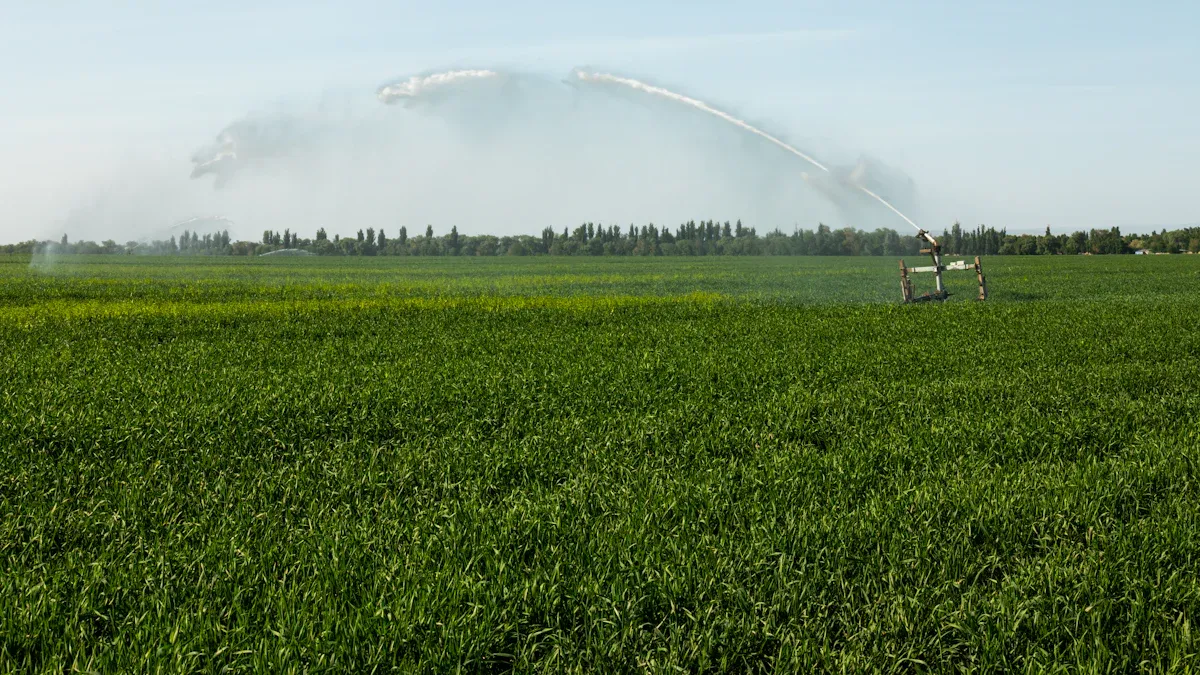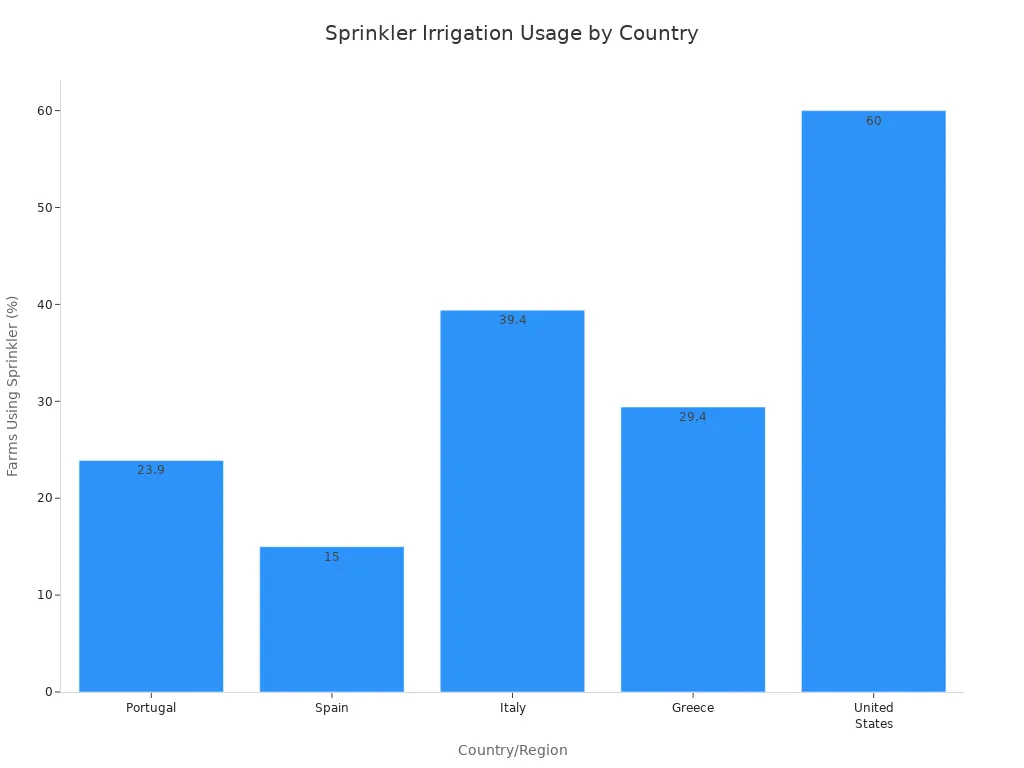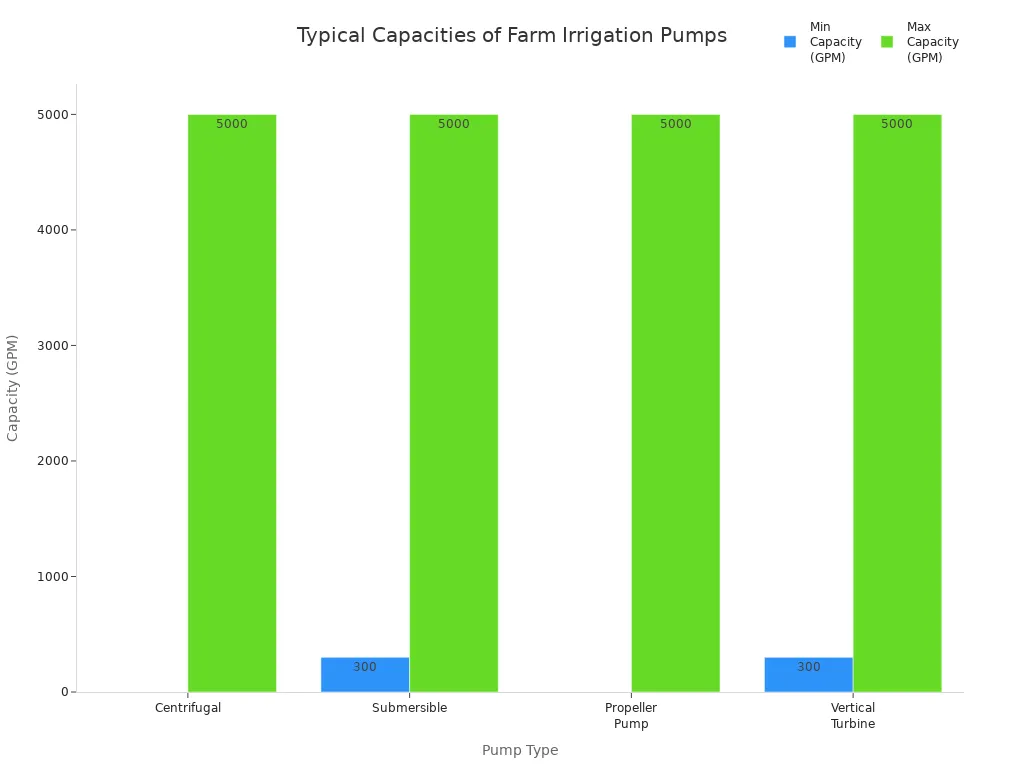
Farm sprinkler irrigation uses pipes and spray heads to deliver water to crops, mimicking natural rainfall. Farmers rely on farm sprinkler irrigation to distribute water evenly, ensuring all plants in the field receive adequate moisture. Water is pumped through pipes and released from sprinkler heads as fine droplets. This method effectively covers the soil surface and promotes healthy crop growth. Many farms benefit from farm sprinkler irrigation by saving up to 25% more water compared to other irrigation methods. The usage of farm sprinkler irrigation varies by region, as shown in the table below:
Region/Country | Percentage of Farms Using Sprinkler Irrigation |
Portugal | 23.9% |
Spain | ~15% |
Italy | 39.4% |
Greece | 29.4% |
United States (US) | Approximately 60% (dominant irrigation type) |

Key Takeaways
Sprinkler irrigation gives water like rain. It helps crops grow strong. It uses less water than other ways.
The system has pumps, pipes, and sprinkler heads. These parts spread water evenly on fields. It works well on many soils and land shapes.
Picking the right pump, pipes, and sprinkler heads is important. This makes the system work well. It also saves water and energy.
There are different sprinkler types for different farms and crops. Farmers should choose systems that fit their land and needs.
Regular care and smart controls help farmers save water. They also lower costs and keep crops healthy all season.
Farm Sprinkler Irrigation Basics
What Is Sprinkler Irrigation
Sprinkler irrigation gives water to crops by spraying it in the air, like rain. Pipes and sprinkler heads spread water across the soil. The goal is to give crops enough water at the right time. This helps plants grow well and saves water.
Sprinkler irrigation works for many soils and crops. Farmers use it to make sure all parts of the field get water, even on hills or slopes.
The main ideas of sprinkler irrigation are:
Making water fall like rain to help crops.
Using pumps, pipes, and sprinklers to move water.
Changing the system for different soils, crops, and weather.
Saving water and working for farms of any size.
Farm sprinkler irrigation helps farmers use water better and grow more crops. It is an important part of modern farm irrigation.
How It Works
Sprinkler irrigation systems move water from a source, like a well or reservoir, through pipes. A pump pushes water through the pipes to the sprinklers. The sprinklers spray water in small drops over the crops and soil.
Water moves through the system in these steps:
The pump takes water from the source and makes pressure.
Main and secondary pipes move water from the pump to laterals, which are smaller pipes.
Laterals bring water to the sprinkler heads. These pipes are light and easy to move.
Sprinkler heads turn water into small drops and spread it over the crops, like rain.
Component | Role in Water Movement and Distribution |
Pump | Pulls water from the source and makes pressure for the system. |
Main and Secondary Pipes | Carry water from the pump to the laterals, above or below ground. |
Laterals | Move water from main pipes to sprinklers, and are easy to move. |
Sprinkler Heads | Spray water in small drops, covering the soil and crops evenly. |
Farmers think about many things when setting up sprinkler irrigation. The type and space between sprinkler heads, their height, and pump pressure all matter for even water spread. Wind and weather can change how water falls on the field. Good planning and care keep the system working well.
Farm sprinkler irrigation systems use these steps to give water where and when crops need it. This helps plants grow strong and lets farmers use water wisely.
System Components
Pump and Water Source
A sprinkler irrigation system needs a good water source and a pump. The pump pulls water from wells, rivers, or reservoirs. It makes enough pressure for the water to move. Centrifugal pumps are common on small and medium farms. They are easy to fix and work well with shallow water. Submersible pumps go deep into wells and last many years. Vertical turbine pumps also work in deep wells and move lots of water. Propeller pumps move large amounts of water but only lift it a short way. Tractors often power these pumps.
Pump Type | Typical Use Case | Typical Capacity Range (GPM) | Notes on Operation and Power Source |
Centrifugal | Lawn irrigation, small to mid-sized farms | 0 to 5,000 | Electric, diesel, petrol, or PTO powered |
Submersible | Deep wells | 300 to 5,000+ | Electric motor submerged with pump |
Jet Pump | Shallow and deep wells | Lower flow capacity | Versatile, higher maintenance |
Propeller Pump | Large volumes, low lift conditions | 0 to 5,000+ | Often PTO powered |
Vertical Turbine | Deep wells, surface water systems | 300 to 5,000+ | Multi-stage impellers, efficient |

Tip: Picking the right pump keeps water flowing well and helps the system work better.
Pipes and Laterals
Pipes and laterals move water from the pump to the sprinklers. Main lines, made of PVC, carry water across the farm. Lateral lines branch off and bring water closer to crops. Farmers pick pipe size based on how much water is needed. A 3/4 inch pipe works for one sprinkler. A 1-1/2 inch pipe can serve three sprinklers. Most pipes use Class 200 PVC because it is strong and lasts long.
Pipe Type | Material | Typical Use | Diameter Range |
Main Lines | PVC | Main distribution | 1" to 3" |
Lateral Lines | PVC | Laterals | 3/4" to 1-1/2" |
Flexible pipe | Vinyl | To sprinkler heads | Variable |
Note: Using the right pipe size stops leaks and keeps water pressure steady in the system.
Sprinkler Heads
Sprinkler heads decide how water spreads over the field. Farmers pick different types for their crops and land. Rotary sprinkler heads spin and cover big areas. They help stop water from running off. Impact sprinklers have a moving arm and spray water far. They work well on bumpy ground. Fixed spray heads make a fan shape for small spaces. Micro-sprinklers and drip emitters put water right at the roots. This saves water and stops it from drying up fast.
Rotary sprinklers: Good for big fields and even watering.
Impact sprinklers: Strong, adjustable, and work on rough ground.
Fixed spray heads: Best for small or medium areas.
Micro-sprinklers and drip emitters: Give water right to roots in gardens or orchards.
Picking the right sprinkler head helps save water and keeps crops safe.
Controls
Modern irrigation systems use smart controls to save water and time. Controllers let farmers set when to water and change plans for weather or soil. Some systems use sensors to check soil moisture, water flow, and pressure. Many farms use remote controls or phone apps to watch and manage watering from anywhere. These smart controls help farmers act fast and keep plants healthy.
Smart controls can cut water use by over 40% and lower energy bills, making farming better.
Sprinkler Irrigation Types
Sprinkler irrigation has different ways to water crops. Farmers pick a system based on their field, crop, and water source. Each type has special features and good points.
Center Pivot
Center pivot systems spin around a center point.
Long pipes with sprinklers are held up by towers with wheels.
Electric motors move the system in a big circle.
Nozzle sizes change from the middle to the edge for even water.
These systems can water up to 125 acres each.
They are common in the United States, Australia, and Brazil.
Center pivot irrigation is very efficient, often over 85%.
It helps stop water loss from evaporation.
Center pivot systems work best on big, flat fields. They are good for crops like corn, soybeans, and wheat.
Lateral Move
Lateral move systems, also called linear move, go straight across fields. The system uses a moving tower, not a fixed center. Water comes from a canal or pipe under the ground. This method is good for fields with rows, like grains and pasture. Lateral move irrigation covers more land than center pivot. It gives even water to all parts of the field. Farmers use it for big fields or special crops.
Solid Set
Aspect | Advantages | Limitations |
Suitability | Good for frost protection | High starting cost |
Operation | Easy to use, pipes stay in place | Pipes can get in the way of field work |
Labor | Not much work after setup | Need work to set up and take down |
Adaptability | Can use with fertigation | High yearly pumping costs |
Coverage | Covers trees and orchard floor well | Costs about $3,500 per acre |
Solid set sprinkler irrigation uses pipes and sprinklers that do not move. Farmers use valves to control each line. These systems are popular in orchards and for frost protection.
Hand-Move and Portable
Hand-move and portable systems are good for small or odd-shaped fields.
Farmers move the pipes and sprinklers by hand.
These systems cost less to put in.
They need more work, about one hour per acre.
Farmers use them when they must move the system a lot or cannot use a permanent system.
Big Gun and Rain Gun
Sprinkler Model | Flow Range (GPM) | Throw Radius (feet) | Operating Pressure (PSI) |
Nelson 100 Series Big Gun | 40 - 300 | 90 - 190 | 40 - 110 |
1-1/4" Impact Rain Gun | 28 - 82 | 62.3 - 95.1 | 30 - 70 |
Big gun and rain gun systems spray lots of water far away. Farmers use these for big jobs, like watering large fields fast. These systems are good for crops that need a lot of water.
Picking the right sprinkler irrigation type helps farmers give crops the water they need.
Pros and Cons
Advantages
Sprinkler irrigation has many good points for farms. This system puts water right where it is needed. It helps stop water from being wasted by evaporation or runoff. Farmers can water big fields quickly and easily. It works for many kinds of crops and land shapes. Sprinkler irrigation is simple to set up and change. It fits both small and large fields.
Sprinkler irrigation systems let farmers control soil moisture better than old ways. This means plants grow healthier and farmers get more crops.
A study in the North China Plain looked at winter wheat. It found that sprinkler irrigation made yields go up by 12% to 14% over surface irrigation. The system also cut down on water loss. This helped crops use water better and grow stronger. New tools, like precision sprinklers and soil moisture sensors, help farmers not use too much water. These tools save water and help farms last longer.
Key advantages include:
Water spreads evenly across the field
Works for many crops and land types
Needs less work and is easy to change
Makes crops grow better and healthier
Uses water in a smarter way
Disadvantages
Sprinkler irrigation also has some problems. Wind and evaporation can make a lot of water disappear, especially in dry places. For example, big guns and pivot end guns can lose up to 40% of water to wind and evaporation. This means less water gets to the crops and the system does not work as well.
Some crops, like fruit trees, do not get as much help from sprinkler irrigation. Tree trunks can block the spray. Water on leaves can dry up before it reaches the ground. If water pressure or sprinkler nozzles are not set right, water may not spread evenly. Wet leaves and soil between rows can also cause more plant diseases and weeds.
Disadvantage | Impact on Irrigation |
Wind and evaporation losses | Lower water efficiency |
Uneven water distribution | Some plants get too much or too little water |
Higher energy use | Increased operational costs |
Disease and weed risk | More favorable conditions for fungi and weeds |
Farmers need to plan well and take care of their systems. This helps them fix these problems and get the most from sprinkler irrigation.
Choosing a Sprinkler System
Farm Size and Crop Type
Farmers need to pick a sprinkler system that fits their land size and crops. Small farms often use single-sprinkler or solid-set systems. These are good for gardens or fields smaller than 50 acres. Medium farms may use moved lateral systems. These let farmers move pipes and sprinklers by hand. Large farms with flat land often use center pivot or lateral move systems. These systems cover big areas and save time.
The type of crop also matters when picking a system. Most row, field, and tree crops do well with sprinkler irrigation. Some crops, like lettuce, need gentle sprays so they do not get hurt. Sprinkler systems work best for sandy soils. They can also work on slopes if pipes follow the land’s shape.
Tip: Farmers should think about both farm size and crop type before picking a system.
Common System Choices by Farm Size:
Small: Single-sprinkler, solid-set
Medium: Moved lateral
Large: Center pivot, lateral move
Water Source and Quality
A good water source is important for any crop irrigation system. Farmers use wells, rivers, ponds, or rainwater. The kind and quality of water change how the system is built. Clean water stops pipes and sprinkler heads from getting blocked. Water with lots of salts, minerals, or dirt can hurt plants and block the system.
Farmers should test water for:
pH (should be 5.0–7.0)
Salinity and sodium levels
Suspended solids and minerals
Toxic elements like boron or heavy metals
If water is not clean, filters or chemicals may be needed. Underground water is steady for irrigation. Surface water may need more care.
Cost and Maintenance
Sprinkler system costs depend on the type and size. It can cost from $1,000 to $7,000 per acre to install a system. Drip irrigation costs less but may not work for all crops or big fields. Maintenance means checking for leaks, cleaning sprinkler heads, and fixing broken parts.
Typical Maintenance Tasks:
Inspect and clean sprinkler heads
Check water pressure and valves
Repair leaks and replace damaged parts
Clean filters to keep water flowing
Regular care keeps the system working well and saves money over time. New tools, like automatic controls and soil sensors, help farmers use water better and do less work.
Note: Farmers should think about both the starting cost and long-term savings. They should pick a system that fits their budget and what they can take care of.
Sprinkler irrigation helps farmers water crops like rain. It uses pumps, pipes, and different sprinklers. Each part, like pumps, valves, and sprinkler heads, is important. Farmers need to know about these parts to choose the best system.
System Part | Why It Matters for Farmers |
Pump | Gives water enough pressure |
Controller/Timer | Sets watering times to save water |
Sprinkler Heads | Makes sure crops get the right amount |
Farmers should pick a system that fits their field size. They also need to think about their water source and how much money they have. Sprinkler irrigation helps farms use less water and grow more crops.
FAQ
What crops work best with sprinkler irrigation?
Sprinkler irrigation works for many kinds of crops. Farmers use it for vegetables, grains, and fruit trees. It is good for crops that need water spread out evenly. Potatoes, carrots, onions, and wheat do well with this system.
How often should farmers run a sprinkler system?
Farmers make watering plans based on what crops need. They also look at the soil and weather. Most crops need water every 3 to 7 days. Soil moisture sensors help farmers know when to water.
Tip: Checking the soil before watering helps save water and stops overwatering.
Can sprinkler systems work on sloped or uneven land?
Yes, sprinkler systems can water fields that are not flat. Farmers change how pipes and sprinklers are set up to fit the land. Good planning helps water reach all parts of the field.
Do sprinkler systems waste water?
Sprinkler systems use water in a smart way. They send water right to the crops and help stop runoff. Using smart controls and fixing the system often saves even more water.
Note: Wind and hot weather can make some water disappear. Farmers often water early or late in the day to save water.















